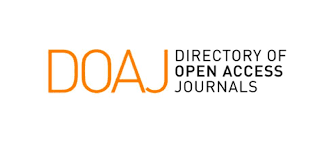The Identification of Landslide Prone Subsurface Structure By Resistivity Geoelectric Method In Pakusari Jember
Abstract
This study aims to determine the subsurface structure in landslide-prone areas and to identify the potential for landslides in Subo Village, Pakusari Subdistrict, Jember. The survey was carried out using the resistivity geoelectrical method with Wenner-Schlumberger configuration and 2 m electrode spacing. Four trajectories of different lengths were used, namely 50 m for Trajectory 1, 30 m for Trajectories 2 and 3, and 26 m for Trajectory 4. The data obtained are the magnitude of the potential difference (V) and the magnitude of the current (I), then processed using Res2dinv software to obtain a 2D section and Voxler to obtain a 3D section. It was found that the subsurface structure consists of clay layer with resistivity of 1,48-37,9 ?m, the next layer is sand layer with resistivity of 8,53-192 ?m and sandstone layer which is quite dominant in Tracks 1 and 4 with resistivity value > 432 ?m. The results of landslide potential identification with 3 indicators were also obtained. It can be concluded that Subo Village, Pakusari Subdistrict, Jember is composed of clay, sand and sandstone layers and has a high landslide potential.
Downloads
References
[2] R. A. Robbi, S. Astutik, dan F. A. Kurnianto, “Kajian Kerawanan Bencana Longsor Berbasis Sistem Informasi Geografis Sebagai Acuan Mitigasi Bencana di Kecamatan Panti, Kabupaten Jember,” … Pembelajaran Geogr., vol. 5, no. 1, pp. 1–18, 2022.
[3] BPBD Jember, “Bencana Tanah Longsor di desa Sumberjeruk Kecamatan Kalisat,” 2022.
[4] Zakiyul Fuadi, M. M, dan M. Yusa, “Identifikasi Lapisan Bawah Permukaan dan Bidang Gelincir Lereng Kelurahan Muara Lembu Metode Geolistrik,” Siklus J. Tek. Sipil, vol. 6, no. 1, pp. 56–66, 2020.
[5] Karmila, “Identifikasi Bidang Gelincir Longsoran Daerah Cempa , Kabupaten Wajo Menggunakan Metode Tahanan Jenis Konfigurasi Wenner-Schlumberger,” Universitas Hasanuddin, 2021.
[6] M. R. Argobi, “Identifikasi Lapisan Batuan Daerah Rawan Longsor dengan Metode Geolistrik Konfigurasi Wenner-Schlumberger di Desa Sagalaherang Kaler Kabupaten Subang Jawa Barat,” Universitas Islam Negeri Syarif Hidayatullah, 2022.
[7] H. L. Sunan dan A. K. Gibran, “Analisis Jenis Struktur Geologi Implikasinya Terhadap Bencana Longsor Daerah Kandangserang Kecamatan Kandangserang Kabupaten Pekalongan Jawa Tengah,” Pros. Semin. Nas. dan Call Pap. ”Pengembangan Sumber Daya Perdesaan dan Kearifan Lokal Berkelanjutan IX” 19- 20 Novemb. 2019 Purwokerto, vol. 9, no. 1, pp. 75–81, 2019.
[8] W. Telford, L. Geldart, R. Sheriff, dan D. Keys, Applied Geophysics, Second. Inggris: Cambridge University Press, 1990.
[9] M. Abduh, E. Bachtiar, S. . Ahmad, dan W. Mustika, Mitigasi Bencana. Indonesia: Tohar Media, 2023.
[10] N. A. Akhirianto dan H. S. Naryanto, “Kajian Kapasitas Dan Persepsi Masyarakat Terhadap Bencana Tanah Longsor Di Desa Margamukti, Kecamatan Pangalengan, Kabupaten Bandung,” J. Ris. Kebencanaan Indones., vol. 2, no. 2, pp. 117–128, 2018.
[11] E. Susanto, “Karakteristik Struktur Tanah Daerah Rawan Bencana Longsor di Desa Kemuninglor Berdasarkan Sifat Kelistrikan Lapisan Bawah Permukaan,” Universitas Jember, 2006.
[12] R. Hidayat, “Aplikasi Sistem Informasi Geografis Untuk Pemetaan,” Pros. Semin. Nas. Geogr. UMS, vol. 11, no. 1, pp. 534–548, 2016.
[13] M. Romosi, “Pendugaan Bidang Gelincir Menggunakan Metode Geolistrik Tahanan Jenis, Masw, Dan Data Mekanika Tanah Di Desa Cimuncang Kec. Malausma Kab. Majalengka,” Universitas Lampung, 2016.
[14] A. Susilo et al., Teori dan Aplikasi Metode Geolistrik Resistivitas. Malang: UB Press, 2022.
[15] R. Mulyasari, I. Gede, B. Darmawan,dan N. Haerudin, “Perbandingan Konfigurasi Elektroda Metode Geolistrik Resistivitas Untuk Identifikasi Litologi Dan Bidang Gelincir Di Kelurahan Pidada Bandar Lampung,” JoP, vol. 6, no. 2, pp. 16–23, 2021.
[16] B. Kanata dan T. Zubaidah, “Aplikasi Metode Geolistrik Tahanan Jenis Konfigurasi Wenner Schlumberger Untuk Survey Pipa Bawah Permukaan,” Tek. Elektro Fak. Tek. Univ. Mataram, vol. 7, no. 2, pp. 84–91, 2008.
[17] H. Hendri, I. D. Faryuni, dan Z. Zulfian, “Identifikasi Bidang Gelincir dan Tipe Tanah Longsor di Daerah Rawan Longsor Desa Bantai Menggunakan Metode Geolistrik,” Prism. Fis., vol. 7, no. 3, pp. 167–174, 2019.
[18] Y. P. Pangestu dan Z. Zulfian, “Identifikasi Struktur Bawah Permukaan Sekitar Daerah Jembatan Kuning Di Desa Korek Menggunakan Metode Geolistrik Konfigurasi Wenner-Schlumberger,” Prism. Fis., vol. 8, no. 1, p. 79, 2020.
[19] M. S. S. Ahmad, S. Sahara, dan A. Wahyuni, “Identifikasi Potensi Longsor Dengan Metode Geolistrik Di Desa Onang Utara Kecamatan Tubo Sendana Kabupaten Majene,” Teknosains Media Inf. Sains dan Teknol., vol. 16, no. 2, pp. 179–190, 2022, doi: 10.24252/teknosains.v16i2.29244.
[20] N. Janna, Rahmaniah, dan A. Wahyuni, “Identifikasi Struktur Batuan Daerah Rawan Longsor Di Kecamatan Camba Kabupaten Maros Berdasarkan Metode Geolistrik Konfigurasi Wenner,” jft, vol. 4, no. 1, pp. 9–16, 2017.
[21] B. J. PPID, “Curah Hujan 2023,” 2024.










